[English] 日本語
 Yorodumi
Yorodumi- PDB-7b5r: Ubiquitin ligation to F-box protein substrates by SCF-RBR E3-E3 s... -
+ Open data
Open data
- Basic information
Basic information
| Entry | Database: PDB / ID: 7b5r | |||||||||
|---|---|---|---|---|---|---|---|---|---|---|
| Title | Ubiquitin ligation to F-box protein substrates by SCF-RBR E3-E3 super-assembly: CUL1-RBX1-SKP1-SKP2-CKSHS1-Cyclin A-CDK2-p27 | |||||||||
 Components Components |
| |||||||||
 Keywords Keywords |  LIGASE / LIGASE /  ubiquitin / ubiquitin /  ubiquitin ligase / ubiquitin ligase /  E3 ligase / E3 ligase /  F-box protein / RBR ligase / Cullin-RING-Ligase / CRL / SCF / F-box protein / RBR ligase / Cullin-RING-Ligase / CRL / SCF /  NEDD8 / NEDD8 /  Post-translational modification / Post-translational modification /  ubiquitylation ubiquitylation | |||||||||
| Function / homology |  Function and homology information Function and homology informationcyclin-dependent protein kinase activating kinase regulator activity / regulation of lens fiber cell differentiation / negative regulation of cardiac muscle tissue regeneration / negative regulation of cyclin-dependent protein kinase activity / autophagic cell death / positive regulation of protein polyubiquitination / Parkin-FBXW7-Cul1 ubiquitin ligase complex / negative regulation of epithelial cell proliferation involved in prostate gland development / FOXO-mediated transcription of cell cycle genes /  F-box domain binding ...cyclin-dependent protein kinase activating kinase regulator activity / regulation of lens fiber cell differentiation / negative regulation of cardiac muscle tissue regeneration / negative regulation of cyclin-dependent protein kinase activity / autophagic cell death / positive regulation of protein polyubiquitination / Parkin-FBXW7-Cul1 ubiquitin ligase complex / negative regulation of epithelial cell proliferation involved in prostate gland development / FOXO-mediated transcription of cell cycle genes / F-box domain binding ...cyclin-dependent protein kinase activating kinase regulator activity / regulation of lens fiber cell differentiation / negative regulation of cardiac muscle tissue regeneration / negative regulation of cyclin-dependent protein kinase activity / autophagic cell death / positive regulation of protein polyubiquitination / Parkin-FBXW7-Cul1 ubiquitin ligase complex / negative regulation of epithelial cell proliferation involved in prostate gland development / FOXO-mediated transcription of cell cycle genes /  F-box domain binding / Phosphorylation of proteins involved in the G2/M transition by Cyclin A:Cdc2 complexes / cyclin A2-CDK1 complex / Aberrant regulation of mitotic exit in cancer due to RB1 defects / PcG protein complex / cell cycle G1/S phase transition / cellular response to luteinizing hormone stimulus / regulation of cell cycle G1/S phase transition / regulation of exit from mitosis / epithelial cell proliferation involved in prostate gland development / cullin-RING ubiquitin ligase complex / negative regulation of phosphorylation / mitotic cell cycle phase transition / negative regulation of epithelial cell apoptotic process / negative regulation of cyclin-dependent protein serine/threonine kinase activity / ubiquitin ligase activator activity / Cul7-RING ubiquitin ligase complex / Transcription of E2F targets under negative control by p107 (RBL1) and p130 (RBL2) in complex with HDAC1 / positive regulation of ubiquitin protein ligase activity / maintenance of protein location in nucleus / cyclin-dependent protein serine/threonine kinase inhibitor activity / Loss of Function of FBXW7 in Cancer and NOTCH1 Signaling / cellular response to leptin stimulus / RHO GTPases activate CIT / F-box domain binding / Phosphorylation of proteins involved in the G2/M transition by Cyclin A:Cdc2 complexes / cyclin A2-CDK1 complex / Aberrant regulation of mitotic exit in cancer due to RB1 defects / PcG protein complex / cell cycle G1/S phase transition / cellular response to luteinizing hormone stimulus / regulation of cell cycle G1/S phase transition / regulation of exit from mitosis / epithelial cell proliferation involved in prostate gland development / cullin-RING ubiquitin ligase complex / negative regulation of phosphorylation / mitotic cell cycle phase transition / negative regulation of epithelial cell apoptotic process / negative regulation of cyclin-dependent protein serine/threonine kinase activity / ubiquitin ligase activator activity / Cul7-RING ubiquitin ligase complex / Transcription of E2F targets under negative control by p107 (RBL1) and p130 (RBL2) in complex with HDAC1 / positive regulation of ubiquitin protein ligase activity / maintenance of protein location in nucleus / cyclin-dependent protein serine/threonine kinase inhibitor activity / Loss of Function of FBXW7 in Cancer and NOTCH1 Signaling / cellular response to leptin stimulus / RHO GTPases activate CIT /  male pronucleus / male pronucleus /  female pronucleus / cyclin-dependent protein serine/threonine kinase activator activity / female pronucleus / cyclin-dependent protein serine/threonine kinase activator activity /  nuclear export / cellular response to cocaine / response to glucagon / SCF-dependent proteasomal ubiquitin-dependent protein catabolic process / AKT phosphorylates targets in the cytosol / cyclin-dependent protein serine/threonine kinase regulator activity / cellular response to insulin-like growth factor stimulus / Cul4A-RING E3 ubiquitin ligase complex / nuclear export / cellular response to cocaine / response to glucagon / SCF-dependent proteasomal ubiquitin-dependent protein catabolic process / AKT phosphorylates targets in the cytosol / cyclin-dependent protein serine/threonine kinase regulator activity / cellular response to insulin-like growth factor stimulus / Cul4A-RING E3 ubiquitin ligase complex /  SCF ubiquitin ligase complex / epithelial cell apoptotic process / cellular response to antibiotic / positive regulation of intracellular estrogen receptor signaling pathway / negative regulation of kinase activity / ubiquitin ligase complex scaffold activity / positive regulation of DNA biosynthetic process / cochlea development / molecular function inhibitor activity / SCF ubiquitin ligase complex / epithelial cell apoptotic process / cellular response to antibiotic / positive regulation of intracellular estrogen receptor signaling pathway / negative regulation of kinase activity / ubiquitin ligase complex scaffold activity / positive regulation of DNA biosynthetic process / cochlea development / molecular function inhibitor activity /  protein kinase inhibitor activity / cyclin A1-CDK2 complex / cyclin E2-CDK2 complex / cyclin E1-CDK2 complex / cellular response to platelet-derived growth factor stimulus / cyclin A2-CDK2 complex / positive regulation of DNA-templated DNA replication initiation / protein kinase inhibitor activity / cyclin A1-CDK2 complex / cyclin E2-CDK2 complex / cyclin E1-CDK2 complex / cellular response to platelet-derived growth factor stimulus / cyclin A2-CDK2 complex / positive regulation of DNA-templated DNA replication initiation /  G2 Phase / cyclin-dependent protein kinase activity / cellular response to lithium ion / G2 Phase / cyclin-dependent protein kinase activity / cellular response to lithium ion /  Y chromosome / Phosphorylation of proteins involved in G1/S transition by active Cyclin E:Cdk2 complexes / positive regulation of heterochromatin formation / p53-Dependent G1 DNA Damage Response / Prolactin receptor signaling / Y chromosome / Phosphorylation of proteins involved in G1/S transition by active Cyclin E:Cdk2 complexes / positive regulation of heterochromatin formation / p53-Dependent G1 DNA Damage Response / Prolactin receptor signaling /  X chromosome / PTK6 Regulates Cell Cycle / protein monoubiquitination / regulation of cyclin-dependent protein serine/threonine kinase activity / regulation of G1/S transition of mitotic cell cycle / Constitutive Signaling by AKT1 E17K in Cancer / regulation of anaphase-promoting complex-dependent catabolic process / cullin family protein binding / Defective binding of RB1 mutants to E2F1,(E2F2, E2F3) / inner ear development / negative regulation of vascular associated smooth muscle cell proliferation / X chromosome / PTK6 Regulates Cell Cycle / protein monoubiquitination / regulation of cyclin-dependent protein serine/threonine kinase activity / regulation of G1/S transition of mitotic cell cycle / Constitutive Signaling by AKT1 E17K in Cancer / regulation of anaphase-promoting complex-dependent catabolic process / cullin family protein binding / Defective binding of RB1 mutants to E2F1,(E2F2, E2F3) / inner ear development / negative regulation of vascular associated smooth muscle cell proliferation /  regulation of DNA replication / centriole replication / Regulation of APC/C activators between G1/S and early anaphase / centrosome duplication / ubiquitin-like ligase-substrate adaptor activity / Telomere Extension By Telomerase / G0 and Early G1 / negative regulation of mitotic cell cycle / cellular response to organic cyclic compound / Activation of the pre-replicative complex / Estrogen-dependent nuclear events downstream of ESR-membrane signaling / cyclin-dependent protein kinase holoenzyme complex / protein K48-linked ubiquitination / cellular response to nitric oxide / response to amino acid / regulation of DNA replication / centriole replication / Regulation of APC/C activators between G1/S and early anaphase / centrosome duplication / ubiquitin-like ligase-substrate adaptor activity / Telomere Extension By Telomerase / G0 and Early G1 / negative regulation of mitotic cell cycle / cellular response to organic cyclic compound / Activation of the pre-replicative complex / Estrogen-dependent nuclear events downstream of ESR-membrane signaling / cyclin-dependent protein kinase holoenzyme complex / protein K48-linked ubiquitination / cellular response to nitric oxide / response to amino acid /  cyclin-dependent kinase / cyclin-dependent kinase /  Cajal body / animal organ regeneration / cyclin-dependent protein serine/threonine kinase activity / localization / Nuclear events stimulated by ALK signaling in cancer Cajal body / animal organ regeneration / cyclin-dependent protein serine/threonine kinase activity / localization / Nuclear events stimulated by ALK signaling in cancerSimilarity search - Function | |||||||||
| Biological species |   Homo sapiens (human) Homo sapiens (human) | |||||||||
| Method |  ELECTRON MICROSCOPY / ELECTRON MICROSCOPY /  single particle reconstruction / single particle reconstruction /  cryo EM / Resolution: 3.8 Å cryo EM / Resolution: 3.8 Å | |||||||||
 Authors Authors | Horn-Ghetko, D. / Prabu, J.R. / Schulman, B.A. | |||||||||
| Funding support |  Germany, 2items Germany, 2items
| |||||||||
 Citation Citation |  Journal: Nature / Year: 2021 Journal: Nature / Year: 2021Title: Ubiquitin ligation to F-box protein targets by SCF-RBR E3-E3 super-assembly. Authors: Daniel Horn-Ghetko / David T Krist / J Rajan Prabu / Kheewoong Baek / Monique P C Mulder / Maren Klügel / Daniel C Scott / Huib Ovaa / Gary Kleiger / Brenda A Schulman /    Abstract: E3 ligases are typically classified by hallmark domains such as RING and RBR, which are thought to specify unique catalytic mechanisms of ubiquitin transfer to recruited substrates. However, rather ...E3 ligases are typically classified by hallmark domains such as RING and RBR, which are thought to specify unique catalytic mechanisms of ubiquitin transfer to recruited substrates. However, rather than functioning individually, many neddylated cullin-RING E3 ligases (CRLs) and RBR-type E3 ligases in the ARIH family-which together account for nearly half of all ubiquitin ligases in humans-form E3-E3 super-assemblies. Here, by studying CRLs in the SKP1-CUL1-F-box (SCF) family, we show how neddylated SCF ligases and ARIH1 (an RBR-type E3 ligase) co-evolved to ubiquitylate diverse substrates presented on various F-box proteins. We developed activity-based chemical probes that enabled cryo-electron microscopy visualization of steps in E3-E3 ubiquitylation, initiating with ubiquitin linked to the E2 enzyme UBE2L3, then transferred to the catalytic cysteine of ARIH1, and culminating in ubiquitin linkage to a substrate bound to the SCF E3 ligase. The E3-E3 mechanism places the ubiquitin-linked active site of ARIH1 adjacent to substrates bound to F-box proteins (for example, substrates with folded structures or limited length) that are incompatible with previously described conventional RING E3-only mechanisms. The versatile E3-E3 super-assembly may therefore underlie widespread ubiquitylation. | |||||||||
| History |
|
- Structure visualization
Structure visualization
| Movie |
 Movie viewer Movie viewer |
|---|---|
| Structure viewer | Molecule:  Molmil Molmil Jmol/JSmol Jmol/JSmol |
- Downloads & links
Downloads & links
- Download
Download
| PDBx/mmCIF format |  7b5r.cif.gz 7b5r.cif.gz | 280.6 KB | Display |  PDBx/mmCIF format PDBx/mmCIF format |
|---|---|---|---|---|
| PDB format |  pdb7b5r.ent.gz pdb7b5r.ent.gz | 221 KB | Display |  PDB format PDB format |
| PDBx/mmJSON format |  7b5r.json.gz 7b5r.json.gz | Tree view |  PDBx/mmJSON format PDBx/mmJSON format | |
| Others |  Other downloads Other downloads |
-Validation report
| Arichive directory |  https://data.pdbj.org/pub/pdb/validation_reports/b5/7b5r https://data.pdbj.org/pub/pdb/validation_reports/b5/7b5r ftp://data.pdbj.org/pub/pdb/validation_reports/b5/7b5r ftp://data.pdbj.org/pub/pdb/validation_reports/b5/7b5r | HTTPS FTP |
|---|
-Related structure data
| Related structure data |  12048MC  7b5lC  7b5mC  7b5nC  7b5sC C: citing same article ( M: map data used to model this data |
|---|---|
| Similar structure data |
- Links
Links
- Assembly
Assembly
| Deposited unit | 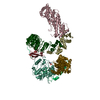
|
|---|---|
| 1 |
|
- Components
Components
-Protein , 3 types, 3 molecules CKY
| #1: Protein |  / CUL-1 / CUL-1Mass: 89800.367 Da / Num. of mol.: 1 Source method: isolated from a genetically manipulated source Source: (gene. exp.)   Homo sapiens (human) / Gene: CUL1 / Production host: Homo sapiens (human) / Gene: CUL1 / Production host:   Escherichia coli (E. coli) / References: UniProt: Q13616 Escherichia coli (E. coli) / References: UniProt: Q13616 |
|---|---|
| #3: Protein | Mass: 9679.211 Da / Num. of mol.: 1 Source method: isolated from a genetically manipulated source Source: (gene. exp.)   Homo sapiens (human) / Gene: CKS1B, CKS1, PNAS-143, PNAS-16 / Production host: Homo sapiens (human) / Gene: CKS1B, CKS1, PNAS-143, PNAS-16 / Production host:   Escherichia coli (E. coli) / References: UniProt: P61024 Escherichia coli (E. coli) / References: UniProt: P61024 |
| #6: Protein | Mass: 48609.574 Da / Num. of mol.: 1 Source method: isolated from a genetically manipulated source Source: (gene. exp.)   Homo sapiens (human) / Gene: CCNA2, CCN1, CCNA / Production host: Homo sapiens (human) / Gene: CCNA2, CCN1, CCNA / Production host:   Escherichia coli (E. coli) / References: UniProt: P20248 Escherichia coli (E. coli) / References: UniProt: P20248 |
-S-phase kinase-associated protein ... , 2 types, 2 molecules TS
| #2: Protein | Mass: 47817.785 Da / Num. of mol.: 1 Source method: isolated from a genetically manipulated source Source: (gene. exp.)   Homo sapiens (human) / Gene: SKP2, FBXL1 / Production host: Homo sapiens (human) / Gene: SKP2, FBXL1 / Production host:   Escherichia coli (E. coli) / References: UniProt: Q13309 Escherichia coli (E. coli) / References: UniProt: Q13309 |
|---|---|
| #4: Protein |  / Cyclin-A/CDK2-associated protein p19 / p19A / Organ of Corti protein 2 / OCP-2 / Organ of Corti ...Cyclin-A/CDK2-associated protein p19 / p19A / Organ of Corti protein 2 / OCP-2 / Organ of Corti protein II / OCP-II / RNA polymerase II elongation factor-like protein / SIII / Transcription elongation factor B polypeptide 1-like / p19skp1 / Cyclin-A/CDK2-associated protein p19 / p19A / Organ of Corti protein 2 / OCP-2 / Organ of Corti ...Cyclin-A/CDK2-associated protein p19 / p19A / Organ of Corti protein 2 / OCP-2 / Organ of Corti protein II / OCP-II / RNA polymerase II elongation factor-like protein / SIII / Transcription elongation factor B polypeptide 1-like / p19skp1Mass: 18679.965 Da / Num. of mol.: 1 Source method: isolated from a genetically manipulated source Source: (gene. exp.)   Homo sapiens (human) / Gene: SKP1, EMC19, OCP2, SKP1A, TCEB1L / Production host: Homo sapiens (human) / Gene: SKP1, EMC19, OCP2, SKP1A, TCEB1L / Production host:   Escherichia coli (E. coli) / References: UniProt: P63208 Escherichia coli (E. coli) / References: UniProt: P63208 |
-Cyclin-dependent kinase ... , 2 types, 2 molecules LP
| #5: Protein |  / Cell division protein kinase 2 / p33 protein kinase / Cell division protein kinase 2 / p33 protein kinaseMass: 34056.469 Da / Num. of mol.: 1 Source method: isolated from a genetically manipulated source Source: (gene. exp.)   Homo sapiens (human) / Gene: CDK2, CDKN2 / Production host: Homo sapiens (human) / Gene: CDK2, CDKN2 / Production host:   Escherichia coli (E. coli) / References: UniProt: P24941, Escherichia coli (E. coli) / References: UniProt: P24941,  cyclin-dependent kinase cyclin-dependent kinase |
|---|---|
| #7: Protein | Mass: 22188.303 Da / Num. of mol.: 1 Source method: isolated from a genetically manipulated source Source: (gene. exp.)   Homo sapiens (human) / Gene: CDKN1B, KIP1 / Production host: Homo sapiens (human) / Gene: CDKN1B, KIP1 / Production host:   Escherichia coli (E. coli) / References: UniProt: P46527 Escherichia coli (E. coli) / References: UniProt: P46527 |
-Details
| Has ligand of interest | N |
|---|
-Experimental details
-Experiment
| Experiment | Method:  ELECTRON MICROSCOPY ELECTRON MICROSCOPY |
|---|---|
| EM experiment | Aggregation state: PARTICLE / 3D reconstruction method:  single particle reconstruction single particle reconstruction |
- Sample preparation
Sample preparation
| Component | Name: NEDD8-CUL1-RBX1-SKP1-SKP2-CKSHS1-Cyclin A-CDK2-p27-UBE2L3~Ub~ARIH1. Transition State 1 composite map. Type: COMPLEX / Entity ID: all / Source: RECOMBINANT |
|---|---|
| Molecular weight | Value: 0.30 MDa |
| Source (natural) | Organism:   Homo sapiens (human) Homo sapiens (human) |
| Source (recombinant) | Organism:   Escherichia coli (E. coli) Escherichia coli (E. coli) |
| Buffer solution | pH: 7.8 |
| Specimen | Embedding applied: NO / Shadowing applied: NO / Staining applied : NO / Vitrification applied : NO / Vitrification applied : YES : YES |
Vitrification | Cryogen name: ETHANE |
- Electron microscopy imaging
Electron microscopy imaging
| Experimental equipment |  Model: Titan Krios / Image courtesy: FEI Company |
|---|---|
| Microscopy | Model: FEI TITAN KRIOS |
| Electron gun | Electron source : :  FIELD EMISSION GUN / Accelerating voltage: 300 kV / Illumination mode: FLOOD BEAM FIELD EMISSION GUN / Accelerating voltage: 300 kV / Illumination mode: FLOOD BEAM |
| Electron lens | Mode: BRIGHT FIELD Bright-field microscopy Bright-field microscopy |
| Image recording | Electron dose: 70 e/Å2 / Film or detector model: GATAN K3 BIOQUANTUM (6k x 4k) |
- Processing
Processing
| Software | Name: PHENIX / Version: 1.18.2_3874: / Classification: refinement | ||||||||||||||||||||||||
|---|---|---|---|---|---|---|---|---|---|---|---|---|---|---|---|---|---|---|---|---|---|---|---|---|---|
CTF correction | Type: PHASE FLIPPING AND AMPLITUDE CORRECTION | ||||||||||||||||||||||||
3D reconstruction | Resolution: 3.8 Å / Resolution method: FSC 0.143 CUT-OFF / Num. of particles: 213213 / Symmetry type: POINT | ||||||||||||||||||||||||
| Refine LS restraints |
|
 Movie
Movie Controller
Controller













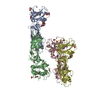



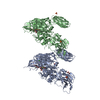
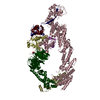

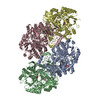
 PDBj
PDBj























